handbrake SKODA ROOMSTER 2012 1.G User Guide
[x] Cancel search | Manufacturer: SKODA, Model Year: 2012, Model line: ROOMSTER, Model: SKODA ROOMSTER 2012 1.GPages: 194, PDF Size: 4.8 MB
Page 93 of 194
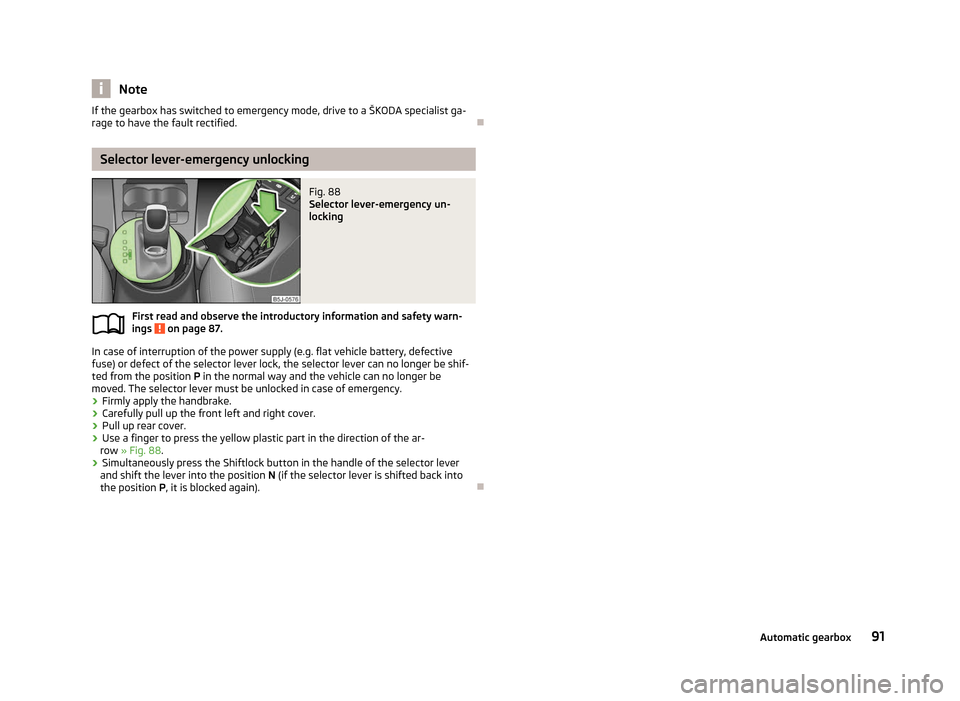
Note
If the gearbox has switched to emergency mode, drive to a ŠKODA specialist ga-
rage to have the fault rectified. ÐSelector lever-emergency unlocking
Fig. 88
Selector lever-emergency un-
locking
First read and observe the introductory information and safety warn-
ings on page 87.
In case of interruption of the power supply (e.g. flat vehicle battery, defective
fuse) or defect of the selector lever lock, the selector lever can no longer be shif-
ted from the position P in the normal way and the vehicle can no longer be
moved. The selector lever must be unlocked in case of emergency.
› Firmly apply the handbrake.
› Carefully pull up the front left and right cover.
› Pull up rear cover.
› Use a finger to press the yellow plastic part in the direction of the ar-
row » Fig. 88 .
› Simultaneously press the Shiftlock button in the handle of the selector lever
and shift the lever into the position N (if the selector lever is shifted back into
the position P , it is blocked again). Ðä
91
Automatic gearbox
Page 128 of 194

Immediately reduce your speed as soon as even the slightest swaying of the trail-
er is detected. Never attempt to stop the trailer from “swaying” by accelerating.
Brakes
Apply the brakes in good time! If the trailer is fitted with a trailer brake, apply the
brakes gently at first, then brake firmly. This will avoid brake jolts resulting from
the trailer wheels locking. On downhill sections shift down a gear in good time to
also use the engine as a brake.
Trailer is connected to the anti-theft alarm system.
› If the vehicle is factory-fitted with an anti-theft alarm system and a towing de-
vice.
› If the trailer is electrically connected to the towing vehicle by means of the trail-
er socket.
› If the electrical system of the vehicle and trailer is fully functional.
› If the vehicle is locked with the car key and the anti-theft alarm system is acti-
vated.
When the vehicle is locked, the alarm is activated as soon as the electrical con-
nection to the trailer is interrupted.
Always deactivate the anti-theft alarm system before a trailer is connected/dis-
connected. Otherwise, the anti-theft alarm system could accidentally be trig-
gered » page 30, Anti-theft alarm system .
Engine overheating
If the needle for the coolant temperature gauge moves into the right-hand area
or the red area of the scale, the speed must be reduced immediately. Stop and
switch off the engine if the warning light in the instrument cluster starts to
flash. Wait a few minutes and check the level of coolant in the coolant expansion
bottle » page 141, Checking the coolant level .
The following guidelines must be observed » page 19, Coolant temperature/cool-
ant level .
The coolant temperature can be reduced by switching on the heating. WARNING
■ Adapt your speed to the conditions of the road surface and to the traffic sit-
uation.
■ Improper or incorrectly connected electric cables can energise the trailer and
cause functional faults to the vehicle's entire electrical system as well as acci-
dents and severe injuries.
■ Any work on the electrical system must be carried out only by ŠKODA spe-
cialist garages.
■ Never directly connect the trailer's electrical system with the electrical con-
nections for the tail lights or other current sources. CAUTION
■ Avoid abrupt and sudden driving/braking manoeuvres.
■ When the ball rod is removed, the mounting shaft must be sealed with an ap-
propriate cover. This prevents foreign matter from penetrating into the mounting
shaft. See the fitting instructions for the towing device. Note
■ We recommend that you also have your vehicle inspected between service in-
tervals if you tow a trailer frequently. ■ The handbrake on the towing vehicle must be put on when coupling and decou-
pling the trailer.
■ For technical reasons, trailers with rear LED lights cannot be connected to the
anti-theft alarm system. Ð
126 Driving Tips
Page 138 of 194
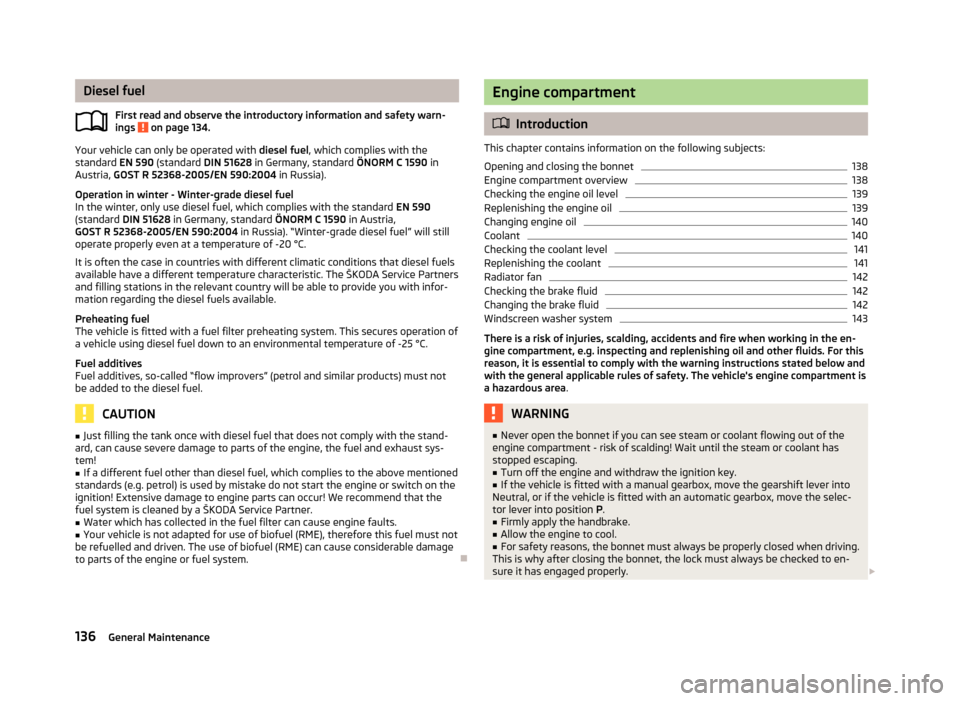
Diesel fuel
First read and observe the introductory information and safety warn-
ings on page 134.
Your vehicle can only be operated with
diesel fuel, which complies with the
standard EN
590 (standard DIN 51628 in Germany, standard ÖNORM C 1590 in
Austria, GOST R 52368-2005/EN 590:2004 in Russia).
Operation in winter - Winter-grade diesel fuel
In the winter, only use diesel fuel, which complies with the standard EN 590
(standard DIN 51628 in Germany, standard ÖNORM C 1590 in Austria,
GOST R 52368-2005/EN 590:2004 in Russia). “Winter-grade diesel fuel” will still
operate properly even at a temperature of -20 °C.
It is often the case in countries with different climatic conditions that diesel fuels
available have a different temperature characteristic. The ŠKODA Service Partners
and filling stations in the relevant country will be able to provide you with infor-
mation regarding the diesel fuels available.
Preheating fuel
The vehicle is fitted with a fuel filter preheating system. This secures operation of
a vehicle using diesel fuel down to an environmental temperature of -25 °C.
Fuel additives
Fuel additives, so-called “flow improvers” (petrol and similar products) must not
be added to the diesel fuel. CAUTION
■ Just filling the tank once with diesel fuel that does not comply with the stand-
ard, can cause severe damage to parts of the engine, the fuel and exhaust sys-
tem!
■ If a different fuel other than diesel fuel, which complies to the above mentioned
standards (e.g. petrol) is used by mistake do not start the engine or switch on the
ignition! Extensive damage to engine parts can occur! We recommend that the
fuel system is cleaned by a
ŠKODA Service Partner.
■ Water which has collected in the fuel filter can cause engine faults.
■ Your vehicle is not adapted for use of biofuel (RME), therefore this fuel must not
be refuelled and driven. The use of biofuel (RME) can cause considerable damage
to parts of the engine or fuel system. Ð
ä Engine compartment
ä
Introduction
This chapter contains information on the following subjects:
Opening and closing the bonnet 138
Engine compartment overview 138
Checking the engine oil level 139
Replenishing the engine oil 139
Changing engine oil 140
Coolant 140
Checking the coolant level 141
Replenishing the coolant 141
Radiator fan 142
Checking the brake fluid 142
Changing the brake fluid 142
Windscreen washer system 143
There is a risk of injuries, scalding, accidents and fire when working in the en-
gine compartment, e.g. inspecting and replenishing oil and other fluids. For this
reason, it is essential to comply with the warning instructions stated below and
with the general applicable rules of safety. The vehicle's engine compartment is
a hazardous area . WARNING
■ Never open the bonnet if you can see steam or coolant flowing out of the
engine compartment - risk of scalding! Wait until the steam or coolant has
stopped escaping.
■ Turn off the engine and withdraw the ignition key.
■ If the vehicle is fitted with a manual gearbox, move the gearshift lever into
Neutral, or if the vehicle is fitted with an automatic gearbox, move the selec-
tor lever into position P .
■ Firmly apply the handbrake.
■ Allow the engine to cool.
■ For safety reasons, the bonnet must always be properly closed when driving.
This is why after closing the bonnet, the lock must always be checked to en-
sure it has engaged properly. £
136 General Maintenance
Page 160 of 194
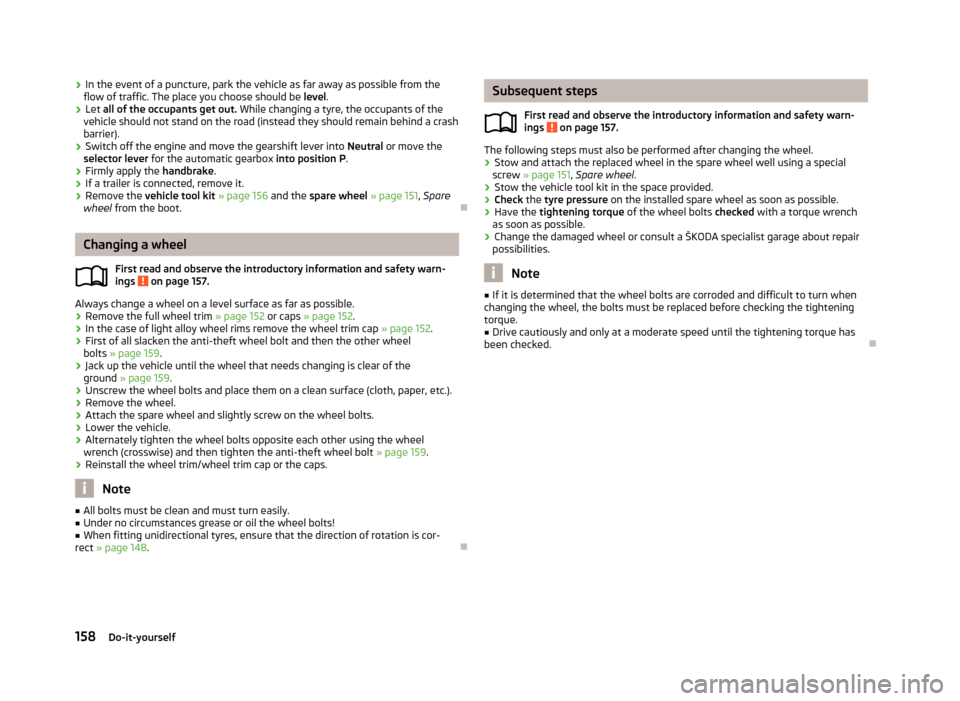
›
In the event of a puncture, park the vehicle as far away as possible from the
flow of traffic. The place you choose should be level.
› Let all of the occupants get out.
While changing a tyre, the occupants of the
vehicle should not stand on the road (instead they should remain behind a crash
barrier).
› Switch off the engine and move the gearshift lever into
Neutral or move the
selector lever for the automatic gearbox into position P .
› Firmly apply the
handbrake.
› If a trailer is connected, remove it.
› Remove the vehicle tool kit
» page 156 and the spare wheel » page 151, Spare
wheel from the boot. ÐChanging a wheel
First read and observe the introductory information and safety warn-
ings on page 157.
Always change a wheel on a level surface as far as possible.
›
Remove the full wheel trim
» page 152 or caps » page 152.
› In the case of light alloy wheel rims remove the wheel trim cap
» page 152.
› First of all slacken the anti-theft wheel bolt and then the other wheel
bolts » page 159.
› Jack up the vehicle until the wheel that needs changing is clear of the
ground » page 159.
› Unscrew the wheel bolts and place them on a clean surface (cloth, paper, etc.).
› Remove the wheel.
› Attach the spare wheel and slightly screw on the wheel bolts.
› Lower the vehicle.
› Alternately tighten the wheel bolts opposite each other using the wheel
wrench (crosswise) and then tighten the anti-theft wheel bolt » page 159.
› Reinstall the wheel trim/wheel trim cap or the caps. Note
■ All bolts must be clean and must turn easily.
■ Under no circumstances grease or oil the wheel bolts!
■ When fitting unidirectional tyres, ensure that the direction of rotation is cor-
rect »
page 148 . Ð
ä Subsequent steps
First read and observe the introductory information and safety warn-
ings on page 157.
The following steps must also be performed after changing the wheel.
›
Stow and attach the replaced wheel in the spare wheel well using a special
screw » page 151, Spare wheel.
› Stow the vehicle tool kit in the space provided.
› Check
the tyre pressure
on the installed spare wheel as soon as possible.
› Have the
tightening torque of the wheel bolts checked with a torque wrench
as soon as possible.
› Change the damaged wheel or consult a ŠKODA specialist garage about repair
possibilities. Note
■ If it is determined that the wheel bolts are corroded and difficult to turn when
changing the wheel, the bolts must be replaced before checking the tightening
torque. ■ Drive cautiously and only at a moderate speed until the tightening torque has
been checked. Ð
ä
158 Do-it-yourself
Page 163 of 194
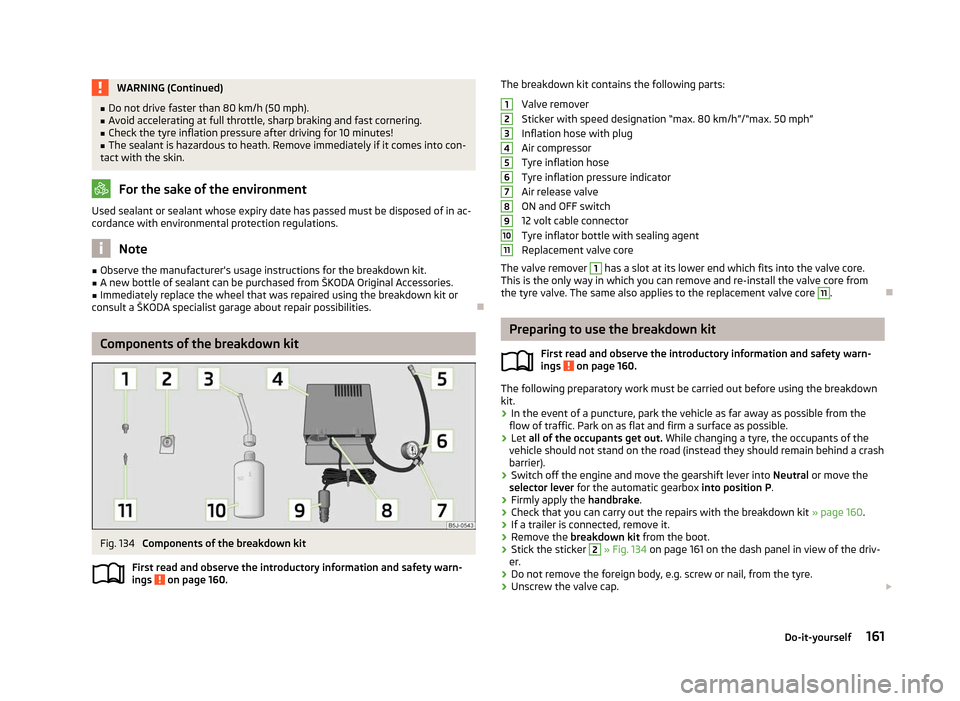
WARNING (Continued)
■ Do not drive faster than 80 km/h (50 mph).
■ Avoid accelerating at full throttle, sharp braking and fast cornering.
■ Check the tyre inflation pressure after driving for 10 minutes!
■ The sealant is hazardous to heath. Remove immediately if it comes into con-
tact with the skin. For the sake of the environment
Used sealant or sealant whose expiry date has passed must be disposed of in ac-
cordance with environmental protection regulations. Note
■ Observe the manufacturer's usage instructions for the breakdown kit.
■ A new bottle of sealant can be purchased from ŠKODA Original Accessories.
■ Immediately replace the wheel that was repaired using the breakdown kit or
consult a ŠKODA specialist garage about repair possibilities. ÐComponents of the breakdown kit
Fig. 134
Components of the breakdown kit
First read and observe the introductory information and safety warn-
ings on page 160.
ä The breakdown kit contains the following parts:
Valve remover
Sticker with speed designation
“max. 80 km/h”/“max. 50 mph”
Inflation hose with plug
Air compressor
Tyre inflation hose
Tyre inflation pressure indicator
Air release valve
ON and OFF switch
12 volt cable connector
Tyre inflator bottle with sealing agent
Replacement valve core
The valve remover 1
has a slot at its lower end which fits into the valve core.
This is the only way in which you can remove and re-install the valve core from
the tyre valve. The same also applies to the replacement valve core 11
.
Ð Preparing to use the breakdown kit
First read and observe the introductory information and safety warn-
ings on page 160.
The following preparatory work must be carried out before using the breakdown
kit.
›
In the event of a puncture, park the vehicle as far away as possible from the
flow of traffic. Park on as flat and firm a surface as possible.
› Let all of the occupants get out.
While changing a tyre, the occupants of the
vehicle should not stand on the road (instead they should remain behind a crash
barrier).
› Switch off the engine and move the gearshift lever into
Neutral or move the
selector lever
for the automatic gearbox into position P .
› Firmly apply the
handbrake.
› Check that you can carry out the repairs with the breakdown kit
» page 160.
› If a trailer is connected, remove it.
› Remove the breakdown kit
from the boot.
› Stick the sticker 2
»
Fig. 134 on page 161 on the dash panel in view of the driv-
er.
› Do not remove the foreign body, e.g. screw or nail, from the tyre.
› Unscrew the valve cap.
£ 1
2
3
4
5
6
7
8
9
10
11
ä
161
Do-it-yourself
Page 186 of 194
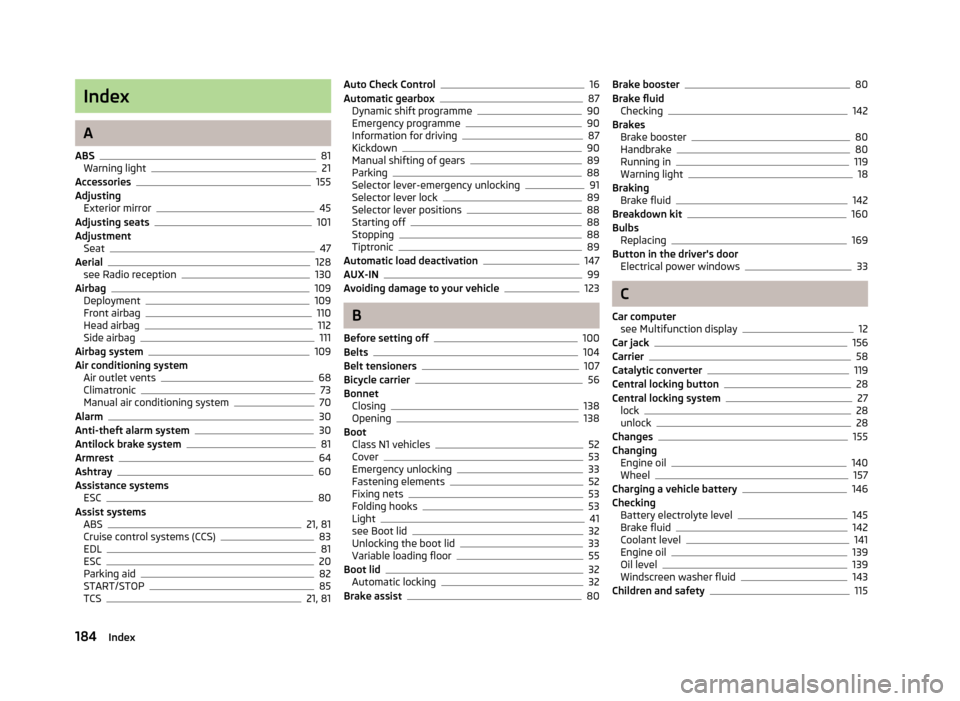
Index
A
ABS 81
Warning light 21
Accessories 155
Adjusting Exterior mirror 45
Adjusting seats 101
Adjustment Seat 47
Aerial 128
see Radio reception 130
Airbag 109
Deployment 109
Front airbag 110
Head airbag 112
Side airbag 111
Airbag system 109
Air conditioning system Air outlet vents 68
Climatronic 73
Manual air conditioning system 70
Alarm 30
Anti-theft alarm system 30
Antilock brake system 81
Armrest 64
Ashtray 60
Assistance systems ESC 80
Assist systems ABS 21, 81
Cruise control systems (CCS) 83
EDL 81
ESC 20
Parking aid 82
START/STOP 85
TCS 21, 81Auto Check Control 16
Automatic gearbox 87
Dynamic shift programme 90
Emergency programme 90
Information for driving 87
Kickdown 90
Manual shifting of gears 89
Parking 88
Selector lever-emergency unlocking 91
Selector lever lock 89
Selector lever positions 88
Starting off 88
Stopping 88
Tiptronic 89
Automatic load deactivation 147
AUX-IN 99
Avoiding damage to your vehicle 123
B
Before setting off 100
Belts 104
Belt tensioners 107
Bicycle carrier 56
Bonnet Closing 138
Opening 138
Boot Class
N1 vehicles 52
Cover 53
Emergency unlocking 33
Fastening elements 52
Fixing nets 53
Folding hooks 53
Light 41
see Boot lid 32
Unlocking the boot lid 33
Variable loading floor 55
Boot lid 32
Automatic locking 32
Brake assist 80Brake booster 80
Brake fluid Checking 142
Brakes Brake booster 80
Handbrake 80
Running in 119
Warning light 18
Braking Brake fluid 142
Breakdown kit 160
Bulbs Replacing 169
Button in the driver's door Electrical power windows 33
C
Car computer see Multifunction display 12
Car jack 156
Carrier 58
Catalytic converter 119
Central locking button 28
Central locking system 27
lock 28
unlock 28
Changes 155
Changing Engine oil 140
Wheel 157
Charging a vehicle battery 146
Checking Battery electrolyte level 145
Brake fluid 142
Coolant level 141
Engine oil 139
Oil level 139
Windscreen washer fluid 143
Children and safety 115
184 Index
Page 188 of 194
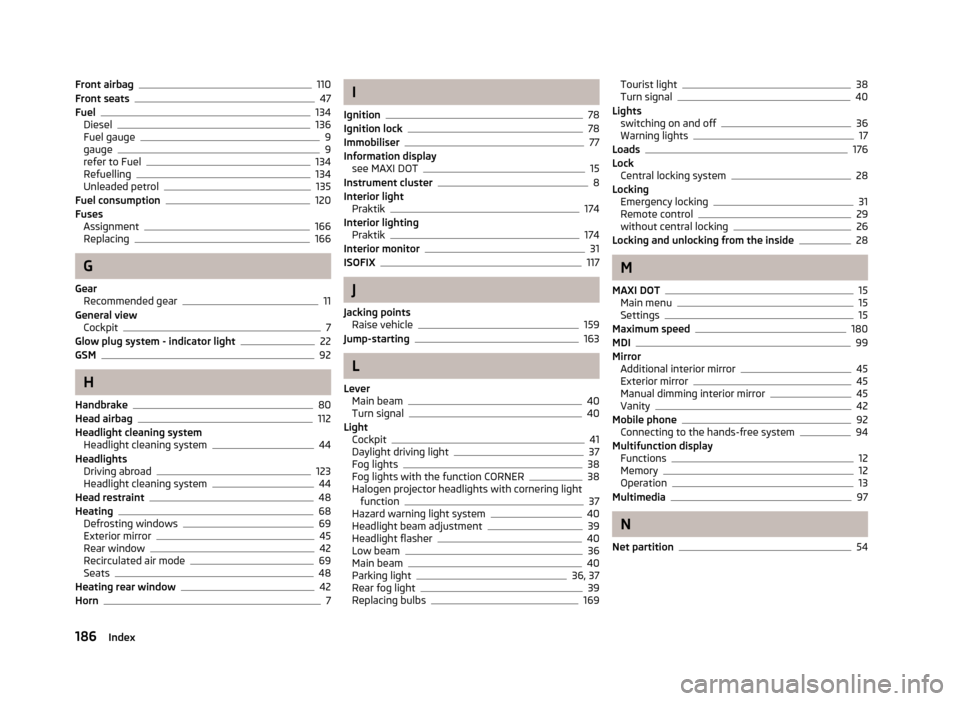
Front airbag 110
Front seats 47
Fuel 134
Diesel 136
Fuel gauge 9
gauge 9
refer to Fuel 134
Refuelling 134
Unleaded petrol 135
Fuel consumption 120
Fuses Assignment 166
Replacing 166
G
Gear Recommended gear 11
General view Cockpit 7
Glow plug system - indicator light 22
GSM 92
H
Handbrake 80
Head airbag 112
Headlight cleaning system Headlight cleaning system 44
Headlights Driving abroad 123
Headlight cleaning system 44
Head restraint 48
Heating 68
Defrosting windows 69
Exterior mirror 45
Rear window 42
Recirculated air mode 69
Seats 48
Heating rear window 42
Horn 7 I
Ignition 78
Ignition lock 78
Immobiliser 77
Information display see MAXI DOT 15
Instrument cluster 8
Interior light Praktik 174
Interior lighting Praktik 174
Interior monitor 31
ISOFIX 117
J
Jacking points Raise vehicle 159
Jump-starting 163
L
Lever Main beam 40
Turn signal 40
Light Cockpit 41
Daylight driving light 37
Fog lights 38
Fog lights with the function CORNER 38
Halogen projector headlights with cornering light function 37
Hazard warning light system 40
Headlight beam adjustment 39
Headlight flasher 40
Low beam 36
Main beam 40
Parking light 36, 37
Rear fog light 39
Replacing bulbs 169Tourist light 38
Turn signal 40
Lights switching on and off 36
Warning lights 17
Loads 176
Lock Central locking system 28
Locking Emergency locking 31
Remote control 29
without central locking 26
Locking and unlocking from the inside 28
M
MAXI DOT 15
Main menu 15
Settings 15
Maximum speed 180
MDI 99
Mirror Additional interior mirror 45
Exterior mirror 45
Manual dimming interior mirror 45
Vanity 42
Mobile phone 92
Connecting to the hands-free system 94
Multifunction display Functions 12
Memory 12
Operation 13
Multimedia 97
N
Net partition 54
186 Index